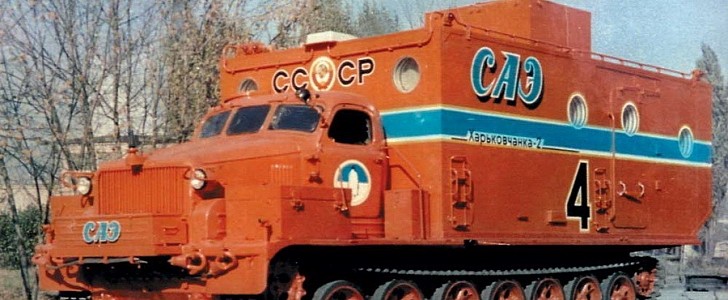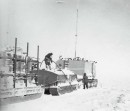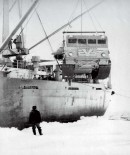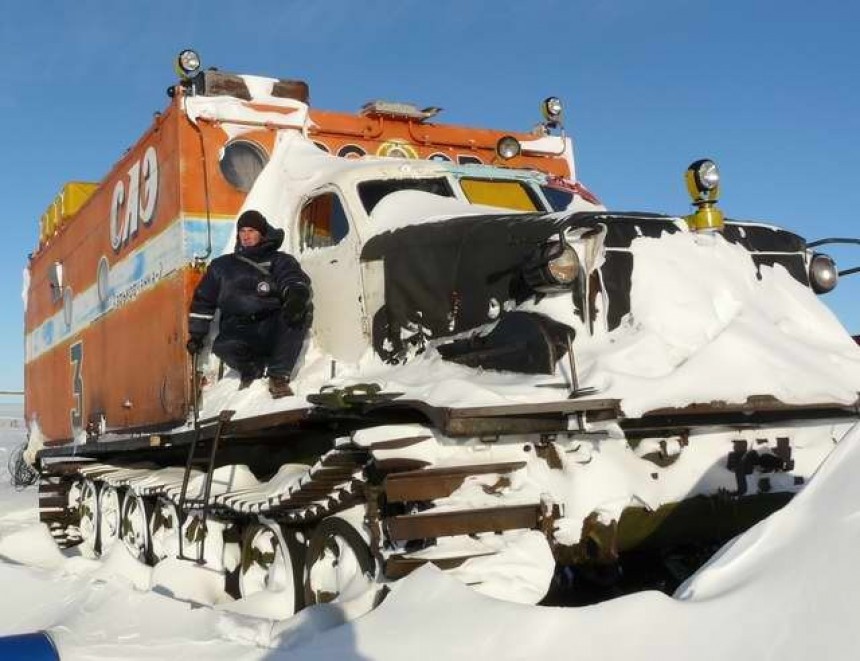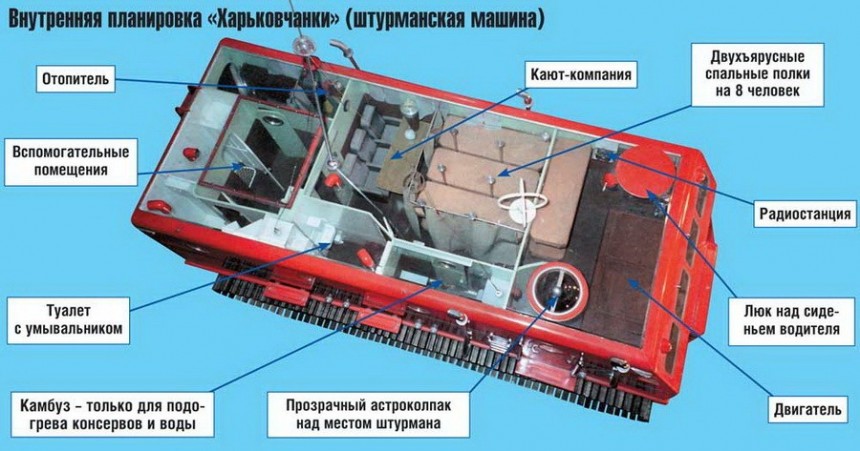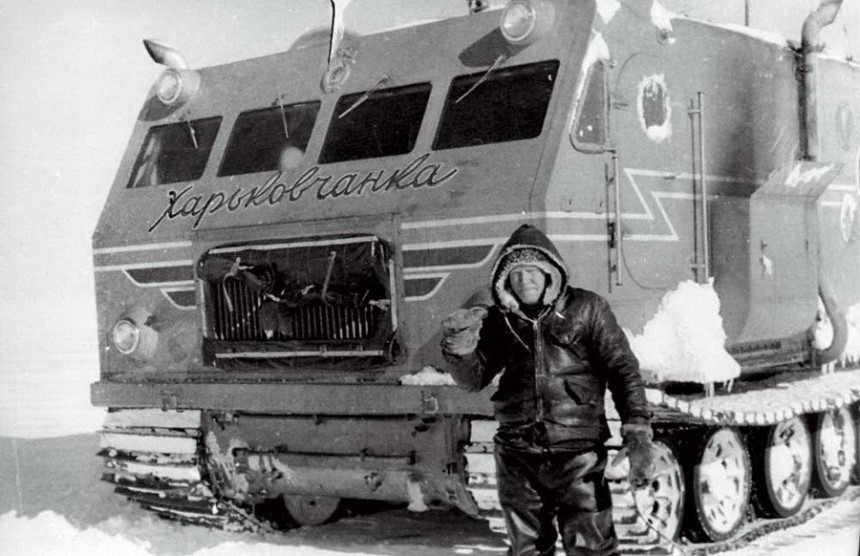If you think today’s overland vehicles are state-of-the-art, try to picture one that can face temperatures of -70 degrees Fahrenheit (-50 degrees Celsius), make its way through snowstorms, carry huge cargo, and still provide decent accommodation for its passengers. Granted, it’s got tracks instead of wheels, but this Soviet Behemoth is a great example of an “igloomobile” for the most daring adventures.
Before the highly-advanced icebreaking explorers and robotic research vessels of our days, there were two land exploration vehicles that made history: America’s Arctic Snow Cruiser and the Soviet Union’s Kharkovchanka. Both of them were born out of the desire to conquer the challenging terrain of Antarctica, for in-depth scientific research. One of them failed, and was lost forever, while the other thrived and continues its service to this day.
The U.S. Antarctic Snow Cruiser was designed in the late 1930s, as an unprecedented type of vehicle for exploration that even came with its own aircraft attached. Unfortunately, since there were no real-world tests performed, as they would have been today, the harsh reality of the Arctic region proved that the concept wasn’t feasible. Then, the World War II broke out and finished it off completely.
By the 1950s, the Soviet Union, as well as other nations, had begun active research in Antarctica. The first Soviet expedition arrived in 1955, and the first station, called Mirny, was established a year later. As more expeditions followed, the explorers realized that the tracked tractors they were using wouldn’t be enough.
A new type of vehicle was required, one that could withstand these incredibly harsh conditions, but also provide safe and comfortable accommodation for the expedition group.
This is how the Kharkovchanka (“woman from Kharkov,” where it was produced) came to be. The new vehicle was based on the ATT heavy artillery tractor, which was a modified tractor using the chassis and drive system of the T-54 tank. This was the first main advantage of the Soviet off-roader, compared to the Arctic Snow Cruiser that had failed because of its unsuitable wheels and tires.
The massive explorer was over 13 feet (4 meters) high and 11.5 feet (3.5 meters) wide, with a length of almost 28 feet (8.5 meters). The cabin was almost the size of a studio apartment (20 square meters/220 square feet), and could accommodate eight people. The cabin’s exterior panels had multiple layers of insulation.
Inside, the group members had access to a small kitchen, a bedroom, a restroom and a vestibule, apart from the control section for the driver and navigator. There was also a separate workshop/laboratory, which made this vehicle a mobile lab as well. The cockpit provided access to the engine, while the fuel was located at the center of the vehicle, under the floor, and the heating system – in the back.
The kitchen was equipped with an electric snow-melting device and an electric stove, where they could heat up canned food. Since the expedition crew wouldn’t be able to get out in the freezing temperatures, the igloomobile was literally a survival vehicle.
An upgraded five-speed gearbox and a turbocharged diesel engine that could deliver over 900 HP allowed the massive off-roader to perform well even at high altitudes. Its caterpillar tracks could handle icy terrain and fluffy snow, and its chassis, although not amphibious, was waterproof. Traveling at a maximum speed of 6.8 mph (11 kph), the massive mobile home could pull one or even two trailer sleds with a total weight of about 77 tons.
In 1959, three fully-equipped Kharkovchanka vehicles, with trailer sleds, arrived at the Mirny station. From there, two of them and an AT-T tractor made an incredible 1,678-mile (2,700 km) journey to the final destination, the South Pole. Some members of the expedition would later recall in their memoirs this unique but challenging experience.
The Kharkovchanka had achieved what the Antarctic Snow Cruiser had dreamt of. For the next years, it would continue to serve as an arctic expedition vehicle. By 1975, the upgraded Kharkovchanka-2 replaced the original version and continues to operate in polar expeditions, to this day. According to Russia Beyond, a third generation was supposed to come out in the ‘80s, but the fall of the Soviet Union put an end to that, as WWII had done with the U.S. futuristic Snow Cruiser.
It’s hard to imagine what it was like traveling inside this Soviet Behemoth, in the most challenging environment possible, but one thing’s for sure: this is one of the greatest overland vehicles/mobile homes in history.
The U.S. Antarctic Snow Cruiser was designed in the late 1930s, as an unprecedented type of vehicle for exploration that even came with its own aircraft attached. Unfortunately, since there were no real-world tests performed, as they would have been today, the harsh reality of the Arctic region proved that the concept wasn’t feasible. Then, the World War II broke out and finished it off completely.
By the 1950s, the Soviet Union, as well as other nations, had begun active research in Antarctica. The first Soviet expedition arrived in 1955, and the first station, called Mirny, was established a year later. As more expeditions followed, the explorers realized that the tracked tractors they were using wouldn’t be enough.
A new type of vehicle was required, one that could withstand these incredibly harsh conditions, but also provide safe and comfortable accommodation for the expedition group.
The massive explorer was over 13 feet (4 meters) high and 11.5 feet (3.5 meters) wide, with a length of almost 28 feet (8.5 meters). The cabin was almost the size of a studio apartment (20 square meters/220 square feet), and could accommodate eight people. The cabin’s exterior panels had multiple layers of insulation.
Inside, the group members had access to a small kitchen, a bedroom, a restroom and a vestibule, apart from the control section for the driver and navigator. There was also a separate workshop/laboratory, which made this vehicle a mobile lab as well. The cockpit provided access to the engine, while the fuel was located at the center of the vehicle, under the floor, and the heating system – in the back.
An upgraded five-speed gearbox and a turbocharged diesel engine that could deliver over 900 HP allowed the massive off-roader to perform well even at high altitudes. Its caterpillar tracks could handle icy terrain and fluffy snow, and its chassis, although not amphibious, was waterproof. Traveling at a maximum speed of 6.8 mph (11 kph), the massive mobile home could pull one or even two trailer sleds with a total weight of about 77 tons.
The Kharkovchanka had achieved what the Antarctic Snow Cruiser had dreamt of. For the next years, it would continue to serve as an arctic expedition vehicle. By 1975, the upgraded Kharkovchanka-2 replaced the original version and continues to operate in polar expeditions, to this day. According to Russia Beyond, a third generation was supposed to come out in the ‘80s, but the fall of the Soviet Union put an end to that, as WWII had done with the U.S. futuristic Snow Cruiser.
It’s hard to imagine what it was like traveling inside this Soviet Behemoth, in the most challenging environment possible, but one thing’s for sure: this is one of the greatest overland vehicles/mobile homes in history.
